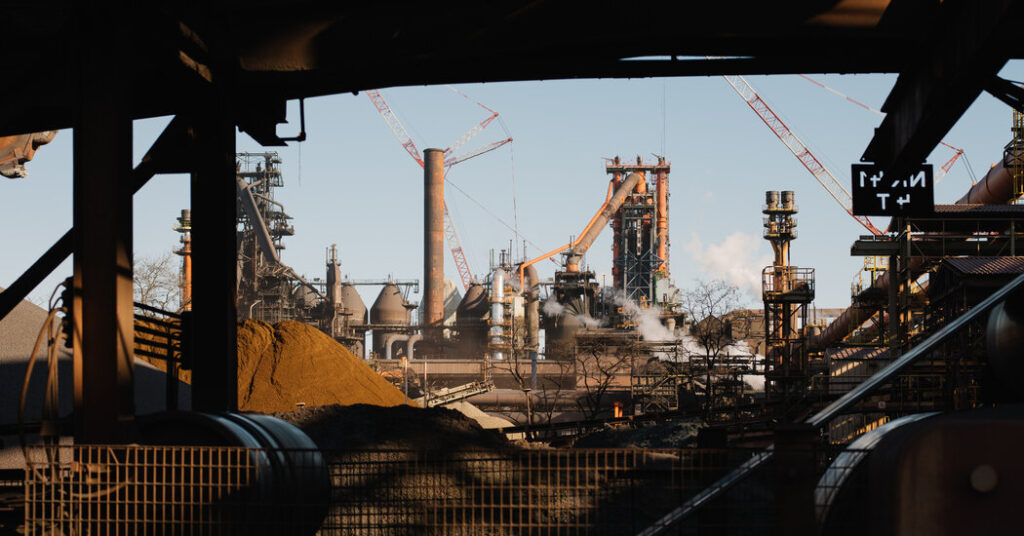Imagine waking up to find that the price of your favorite kitchen pots has skyrocketed overnight. This isn’t just a hypothetical scenario; it’s becoming a reality for many in Europe as the trade war with the United States over steel and aluminum intensifies. The European Union (EU) has been preparing for this moment for months, and now, with new American tariffs in place, the EU is fighting back. Let’s delve into the details of this escalating conflict and what it means for the global economy.
The Trigger: US Tariffs on Steel and Aluminum
The United States, under the Trump administration, imposed a 25% tariff on steel and a 10% tariff on aluminum imports. These measures, which took effect on Wednesday, were aimed at protecting American industries but have far-reaching implications for global trade.
Impact on Key Trading Partners
The US primarily imports steel and aluminum from countries like Canada, Brazil, and Mexico. However, Germany, a significant steel producer within the EU, is also heavily affected by these tariffs.
Europe’s Retaliation: A Two-Part Strategy
The EU’s response to the US tariffs is structured in two parts, aiming to counter the American measures effectively.
First Part: Immediate Tariffs
The EU has already increased tariffs on a range of US goods. These retaliatory measures were initially implemented during President Trump’s first term but were suspended when President Biden took office. However, with the new US tariffs, the EU has reinstated these measures.
Second Part: Long-Term Strategy
Beyond immediate tariffs, the EU is developing a long-term strategy to safeguard its industries. This includes diversifying trade partners and investing in domestic production to reduce reliance on US imports.
The Economic Impact: Billions at Stake
The EU estimates that the US tariffs will affect about 26 billion euros ($28 billion) of its exports. This isn’t just about steel and aluminum; it also includes products made from these materials, like cookware and window frames.
Industries Feeling the Heat
- Manufacturing: Companies using steel and aluminum in their products will see increased costs, which may lead to higher prices for consumers.
- Construction: The construction industry, a major user of steel, will face higher expenses, potentially slowing down projects.
- Automotive: Car manufacturers, already grappling with supply chain issues, will see further disruptions and increased costs.
Global Repercussions: A Ripple Effect
The trade war between the US and the EU is not just a bilateral issue; it has global implications. Countries that rely on trade with both the US and the EU will feel the ripple effects of this conflict.
Impact on Emerging Markets
Emerging markets, which often depend on exports to developed economies, may face reduced demand for their products. This could lead to economic slowdowns and increased unemployment in these regions.
Shifts in Global Trade Patterns
As the EU seeks to diversify its trade partners, other countries may see increased demand for their steel and aluminum. This could lead to shifts in global trade patterns, with countries like China and India potentially benefiting from the EU’s new strategy.
The Human Cost: Jobs and Livelihoods
Beyond the economic numbers, there’s a human cost to this trade war. Jobs in industries affected by the tariffs are at risk, and workers are feeling the pressure.
Stories from the Frontline
Take, for example, Maria, a worker in a German steel plant. She’s been with the company for over a decade and is now worried about her job security. “We’ve seen orders drop, and there’s talk of layoffs,” she says. “It’s scary to think that a decision made thousands of miles away could affect my family’s future.”
Looking Ahead: What’s Next in the Trade War?
The trade war between the US and the EU is far from over. Both sides are digging in, and the stakes are high. So, what can we expect in the coming months?
Negotiations and Diplomacy
There’s hope that negotiations between the US and the EU could lead to a resolution. However, both sides are firm in their positions, and finding common ground will be challenging.
Escalation and Further Retaliation
If negotiations fail, we could see further escalation. The EU might impose additional tariffs on US goods, and the US could respond in kind. This tit-for-tat approach could lead to a prolonged trade war with severe economic consequences.
The Role of Other Global Players
Other countries and international organizations may play a role in mediating the conflict. The World Trade Organization (WTO) could step in to help resolve the dispute, but its effectiveness in such situations has been limited in the past.
Conclusion: Navigating Uncertain Times
The trade war between the US and the EU over steel and aluminum tariffs is a complex issue with far-reaching implications. As both sides continue to retaliate, the global economy faces uncertainty. Consumers, businesses, and workers around the world are feeling the impact of these decisions.
However, there’s also hope. With continued dialogue and a willingness to compromise, a resolution could be reached. Until then, it’s crucial for all stakeholders to stay informed and prepared for the challenges ahead.
In the meantime, as you sip your morning coffee, consider the global forces at play that affect the price of your kitchenware. The trade war between the US and the EU is a reminder of how interconnected our world is and how decisions in one part of the globe can impact us all.
Source: www.nytimes.com
